The Iron Age Dogs from Alaybeyi Höyük, Eastern Anatolia
Abstract
Simple Summary
Abstract
1. Introduction
2. Materials and Methods
2.1. The Site
2.2. Skeletal Remains of the Dogs
2.3. Estimation of Minimum Number of Individuals (MNI)
2.4. Morphometry
2.5. Estimation of Height at Withers and Body Weight
2.6. Estimation of Age
2.7. Estimation of Sex
2.8. Examination of Pathology
2.9. Examination of Butchery Marks
3. Results
4. Discussion
5. Conclusions
Author Contributions
Funding
Institutional Review Board Statement
Informed Consent Statement
Data Availability Statement
Acknowledgments
Conflicts of Interest
References
- Bergström, A.; Frantz, L.; Schmidt, R.; Ersmark, E.; Lebrasseur, O.; Girdland-Flink, L.; Lin, A.T.; Storå, J.; Sjögren, K.-G.; Anthony, D.; et al. Origins and genetic legacy of prehistoric dogs. Science 2020, 370, 557–564. [Google Scholar] [CrossRef] [PubMed]
- Leonard, J.A.; Wayne, R.K.; Wheeler, J.; Valadez, R.; Guillén, S.; Vilà, C. Ancient DNA evidence for Old World origin of New World dogs. Science 2002, 298, 1613–1616. [Google Scholar] [CrossRef]
- Albizuri, S.; Nadal, J.; Martín, P.; Gibaja, J.F.; Cólliga, A.M.; Esteve, X.; Oms, X.; Martí, M.; Pou, R.; López-Onaindia, D.; et al. Dogs in funerary contexts during the Middle Neolithic in the Northeastern Iberian Peninsula (5th–Early 4th millennium BCE). J. Archaeol. Sci. Rep. 2019, 24, 198–207. [Google Scholar] [CrossRef]
- Morey, D.F.; Wiant, M.D. Early Holocene domestic dog burials from the North American Midwest. Curr. Anthropol. 1992, 33, 224–229. [Google Scholar] [CrossRef]
- Özdoğan, A. Çayönü. In Neolithic in Turkey. The Cradle of Civilization. New Discoveries; Özdoğan, M., Başgelen, N., Eds.; Arkeoloji ve Sanat Yayınları: Istanbul, Turkey, 1999; pp. 35–63. [Google Scholar]
- Shigehara, N.; Hongo, H. Ancient remains of Jomon dogs from Neolithic sites in Japan. In Dogs through Time: An Archaeological Perspective; Crockford, S.J., Ed.; BAR International Series; Archaeopress: Oxford, UK, 2000; Volume 889, pp. 61–67. [Google Scholar]
- Tchernov, E.; Valla, F.F. Two new dogs, and other Natufian dogs, from the Southern Levant. J. Archaeol. Sci. 1997, 24, 65–95. [Google Scholar] [CrossRef]
- Guagnin, M.; Perri, A.R.; Petraglia, M.D. Pre-Neolithic evidence for dog-assisted hunting strategies in Arabia. J. Anthropol. Archaeol. 2018, 49, 225–236. [Google Scholar] [CrossRef]
- Russell, N.; Twiss, K.C. Digesting the data: Dogs as taphonomic agents at Neolithic Çatalhöyük, Turkey. In Archaeozoology of the Near East 9: In honour of Hans-Peter Uerpmann and François Poplin; Mashkour, M., Beech, M., Eds.; Oxbow Books: Oxford, UK; Philadelphia, PA, USA, 2017; pp. 59–73. [Google Scholar]
- Siddiq, A.B. Tarihöncesi Toplumlarda Insan-Hayvan Iliskisi ve Orta Anadolu Çanak Çömleksiz Neolitik Dönem Faunasi; Çizgi Kitabevi: Konya, Turkey, 2019. [Google Scholar]
- Kansa, S.W.; Kennedy, A.; Campbell, S.; Carter, E. Resource exploitation at Late Neolithic Domuztepe: Faunal and botanical evidence. Curr. Anthropol. 2009, 50, 897–914. [Google Scholar] [CrossRef]
- Bartosiewicz, L. Interim report on the Bronze Age animal bones from Arslantepe (Malatya, Anatolia). In Archaeozoology of the Near East III: Proceedings of the Third International Symposium on the Archaeozoology of Southwestern Asia and Adjacent Areas; Buitenhuis, H., Bartosiewicz, L., Choyke, A.M., Eds.; ARC Publicaties 18; Centre for Archeological Research and Consultancy: Groningen, The Netherlands, 1998. [Google Scholar]
- Durgun, P. Human-animal interactions in Anatolian mortuary practices. Chronika 2017, 7, 11–27. [Google Scholar]
- Onar, V.; Armutak, A.; Belli, O.; Konyar, E. Skeletal remains of dogs unearthed from the Van-Yoncatepe necropolises. Int. J. Osteoarchaeol. 2002, 12, 317–334. [Google Scholar] [CrossRef]
- Roodenberg, S.A.; Roodenberg, J.J. (Eds.) The Ilıpınar Excavations. 3: Life and Death in a Prehistoric Settlement in Northwest Anatolia: With Contributions on Hacılartepe and Menteşe. In Uitgaven van het Nederlands Instituut voor het Nabije Oosten te Leiden; Nederlands Inst. voor het Nabije Oosten: Leiden, Netherlands, 2008. [Google Scholar]
- Russell, N.; Düring, B.S. Worthy is the lamb: A double burial at Neolithic Çatalhöyük (Turkey). Paléorient 2006, 32, 73–84. [Google Scholar] [CrossRef]
- Satar, Z.; Baykara, İ.; Güleç, E.; Açıkkol, A. Altintepe/Tuşpa nekropolü faunasinin zooarkeolojik analizi. Arkeom. Sonuç. Toplantısı 2006, 21, 51–62. [Google Scholar]
- Açıkkol, A.; Yılmaz, H. Büyükardiç faunasının zooarkeolojik analizi. In Büyükardiç: An Early Iron Age Hilltop Settlement in Eastern Anatolia; Şenyurt, S.Y., Ed.; Gazi University Research Center for Archaeology: Ankara, Turkey, 2005; pp. 277–300. [Google Scholar]
- Boessneck, J.; von den Driesch, A. Tepecikte 1970 İle 1973 yılları arasındaki kazılarda bulunan hayvan kemikleri. Keban Projesi 1973 Çalışmaları Middle East Tech. Univ. Keban Proj. Publ. 1979, I, 95–114. [Google Scholar]
- Siddiq, A.B. Animal remains of Alaybeyi Höyük. Turk. J. Vet. Anim. Sci. 2019, 43, 767–783. [Google Scholar] [CrossRef]
- Collins, B.J. The puppy in Hittite ritual. J. Cuneif. Stud. 1990, 42, 211–226. [Google Scholar] [CrossRef]
- Bökönyi, S. Late Chalcolithic and Early Bronze I animal remains from Arslantepe (Malatya), Turkey: A Preliminary Report. Origini 1983, 12, 581–598. [Google Scholar]
- Onar, V. Estimating the body weight of dogs unearthed from the Van-Yoncatepe necropolis in Eastern Anatolia. Turk. J. Vet. Anim. Sci. 2005, 29, 495–498. [Google Scholar]
- Boessneck, J.; von den Driesch, A. The excavations at Korucutepe, Turkey, 1968–1970: Preliminary report. Part IX: The animal remains. J. East. Stud. 1974, 33, 109–112. [Google Scholar] [CrossRef]
- Howell-Meurs, S. Early Bronze and Iron Age Animal Exploitation in Northeastern Anatolia: The Faunal Remains from Sos Höyük and Büyüktepe Höyük; BAR International Series; Archaeopress: Oxford, UK, 2001. [Google Scholar]
- Howell-Meurs, S. Archaeozoological evidence for pastoral systems and herd mobility: The remains from Sos Höyük and Büyüktepe Höyük. Int. J. Osteoarchaeol. 2001, 11, 321–328. [Google Scholar] [CrossRef]
- Onar, V.; Belli, O. Estimation of shoulder height from long bone measurements on dogs unearthed from the Van-Yoncatepe Early Iron Age necropolis in Eastern Anatolia. Rev. Médecine Vét. 2005, 156, 53–60. [Google Scholar]
- Altunkaynak, G. (Ed.) A New Discovery within the Erzurum Plain from Kura-Araxes to the Alexander the Great: Alaybeyi Höyük; Bilgin Kültür Sanat Yayınları: Ankara, Turkey, 2019. [Google Scholar]
- Altunkaynak, G. Alaybeyi Salvage Excavations. In A New Discovery within the Erzurum Plain from Kura-Araxes to the Alexander the Great: Alaybeyi Höyük; Altunkaynak, G., Ed.; Bilgin Kültür Sanat Yayınları: Ankara, Turkey, 2019; pp. 101–138. [Google Scholar]
- Altunkaynak, G.; Özdemir, M.A. Alaybeyi Höyük Iron Age layers and finds. In A New Discovery within the Erzurum Plain from Kura-Araxes to the Alexander the Great: Alaybeyi Höyük; Altunkaynak, G., Ed.; Bilgin Kültür Sanat Yayınları: Ankara, Turkey, 2019; pp. 183–274. [Google Scholar]
- Siddiq, A.B. Human-animal relationships at Alaybeyi Höyük. In A New Discovery within the Erzurum Plain from Kura-Araxes to the Alexander the Great: Alaybeyi Höyük; Altunkaynak, G., Ed.; Bilgin Kültür Sanat Yayınları: Ankara, Turkey, 2019; pp. 389–420. [Google Scholar]
- Chaplin, R.E. The Study of Animal Bones from Archaeological Sites; Seminar Press: London, UK, 1971. [Google Scholar]
- Harcourt, R.A. The dog in prehistoric and early historic Britain. J. Archaeol. Sci. 1974, 1, 151–175. [Google Scholar] [CrossRef]
- Anyonge, W. Body mass in large extant and extinct carnivores. J. Zool. 1993, 231, 339–350. [Google Scholar] [CrossRef]
- Baker, J.R.; Brothwell, D.R. Animal Diseases in Archaeology; Academic Press: London, UK, 1980. [Google Scholar]
- Davis, S.J.M. The Archaeology of Animals; Routledge: London, UK, 1987. [Google Scholar]
- O’Connor, T. The Archaeology of Animal Bones; Sutton Publishing: Gloucestershire, UK, 2000. [Google Scholar]
- Kooi, R.J.; Fairgrieve, S.I. SEM and stereomicroscopic analysis of cut marks in fresh and burned bone. J. Forensic Sci. 2013, 58, 452–458. [Google Scholar] [CrossRef]
- Domínguez-Rodrigo, M.; de Juana, S.; Galán, A.B.; Rodríguez, M. A new protocol to differentiate trampling marks from butchery cut marks. J. Archaeol. Sci. 2009, 36, 2643–2654. [Google Scholar] [CrossRef]
- Price, M.; Meier, J.; Arbuckle, B. Canine economies of the ancient Near East and Eastern Mediterranean. J. Field Archaeol. 2021, 46, 81–92. [Google Scholar] [CrossRef]
- Onar, V.; Cakirlar, C.; Janeczek, M.; Kiziltan, Z.; Çakirlar, C.; Janeczek, M.; Kiziltan, Z. Skull typology of Byzantine dogs from the Theodosius Harbour at Yenikapi, Istanbul. Anat. Histol. Embryol. J. Vet. Med. Ser. C 2012, 41, 341–352. [Google Scholar] [CrossRef]
- Khatchadourian, L. The Iron Age in Eastern Anatolia. In The Oxford Handbook of Ancient Anatolia: (10,000-323 BCE); McMahon, G., Steadman, S., Eds.; Oxford University Press: New York, NY, USA, 2012; Volume 1, pp. 464–499. [Google Scholar]
- Esin, U. Tepecik kazısı, Keban Projesi 1972 çalışmaları. Orta Doğu Tek. Üniversitesi Keban Projesi Yayın. 1976, I, 101–118. [Google Scholar]
- Onar, V.; Özcan, S.; Pazvant, G. Skull typology of adult male Kangal dogs. Anat. Histol. Embryol. J. Vet. Med. Ser. C 2001, 30, 41–48. [Google Scholar] [CrossRef]
- Siddiq, A.B.; Savaş, B.; Çoşar, E.; Altunkaynak, G. Some ethnoarchaeological notes on Alaybeyi Höyük in the light of present Alaybeyi village. In A New Discovery within the Erzurum Plain from Kura-Araxes to the Alexander the Great: Alaybeyi Höyük; Altunkaynak, G., Ed.; Bilgin Kültür Sanat Yayınları: Ankara, Turkey, 2019; pp. 427–451. [Google Scholar]
- Siddiq, A.B.; Şanlı, S. Animals and pastoral groups in the mountainous Ömerli district of Southeast Anatolia. Anthrozoös 2020, 33, 153–173. [Google Scholar] [CrossRef]
- Ojoade, J.O. Nigerian cultural attitudes to the dog. In Signifying Animals: Human Meaning in the Natural World; Willis, R.G., Ed.; Routledge: London, UK, 1990; pp. 204–210. [Google Scholar]
- Trigger, B.G. The Huron: Farmers of the North, 2nd ed.; Case studies in cultural anthropology; Holt, Rinehart and Winston: Fort Worth, TX, USA, 1990. [Google Scholar]
- Lev-Tov, J.; Killebrew, A.E.; Greenfield, H.J.; Brown, A. Puppy sacrifice and cynophagy from Early Philistine Tel Miqne-Ekron contextualized. J. East. Mediterr. Archaeol. Herit. Stud. 2018, 6, 1–30. [Google Scholar] [CrossRef]
- Wapnish, P.; Hesse, B. Pampered pooches or plain pariahs? The Ashkelon dog burials. Biblic. Archaeol. 1993, 56, 55–80. [Google Scholar] [CrossRef]
- Greenewalt, C.H. Ritual Dinners in Early Historic Sardis; University of California Press: Berkeley, CA, USA, 1978. [Google Scholar]
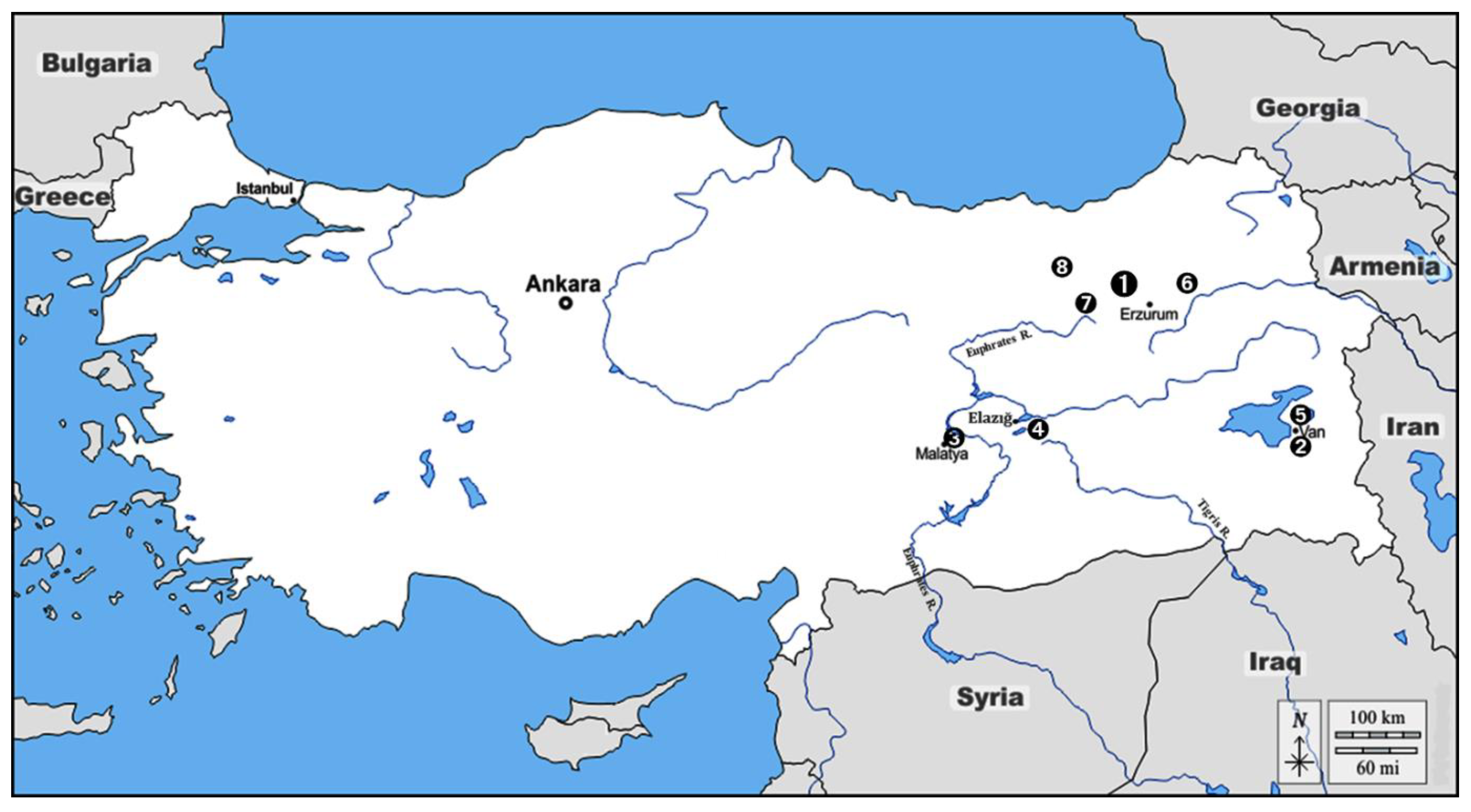
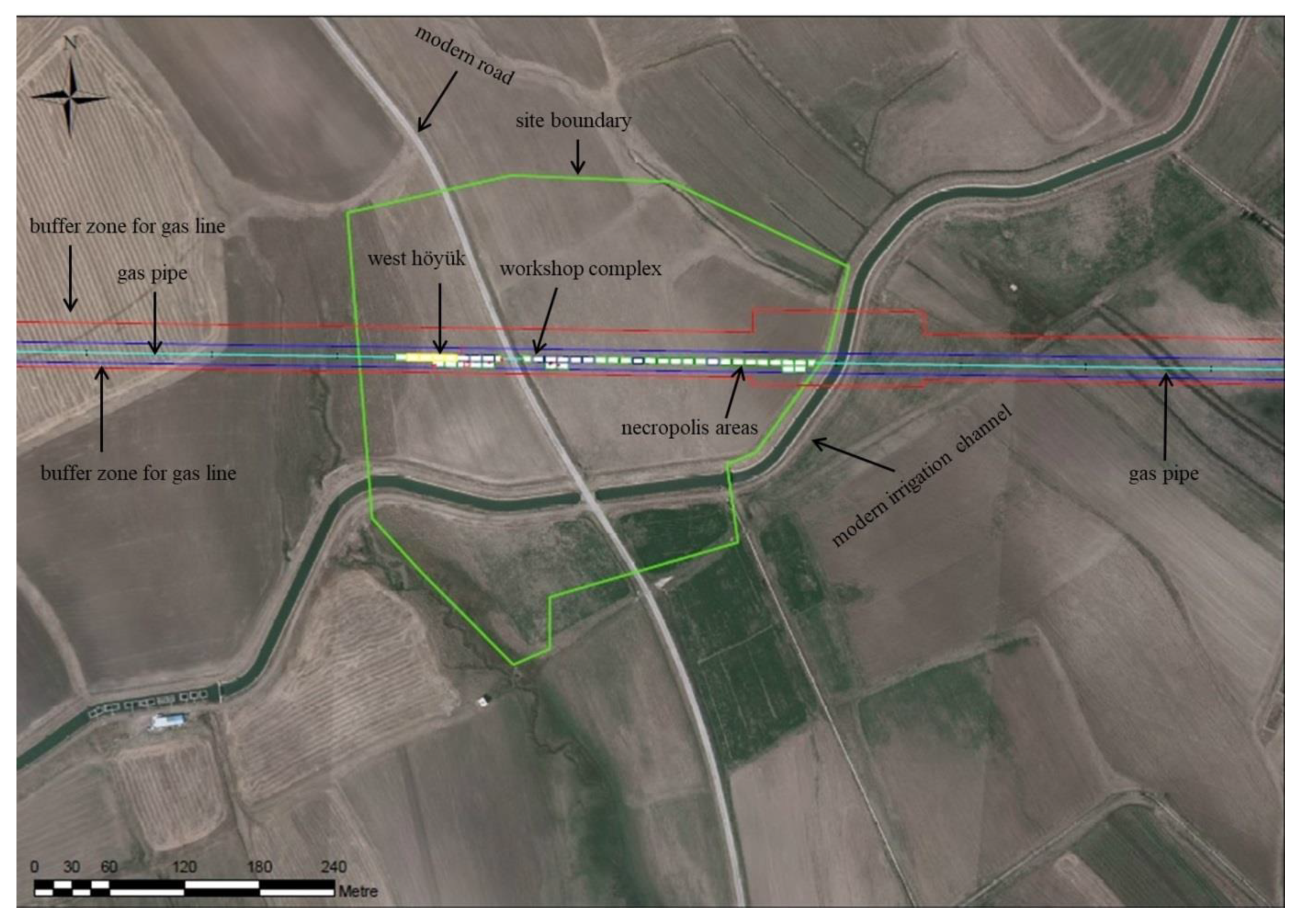
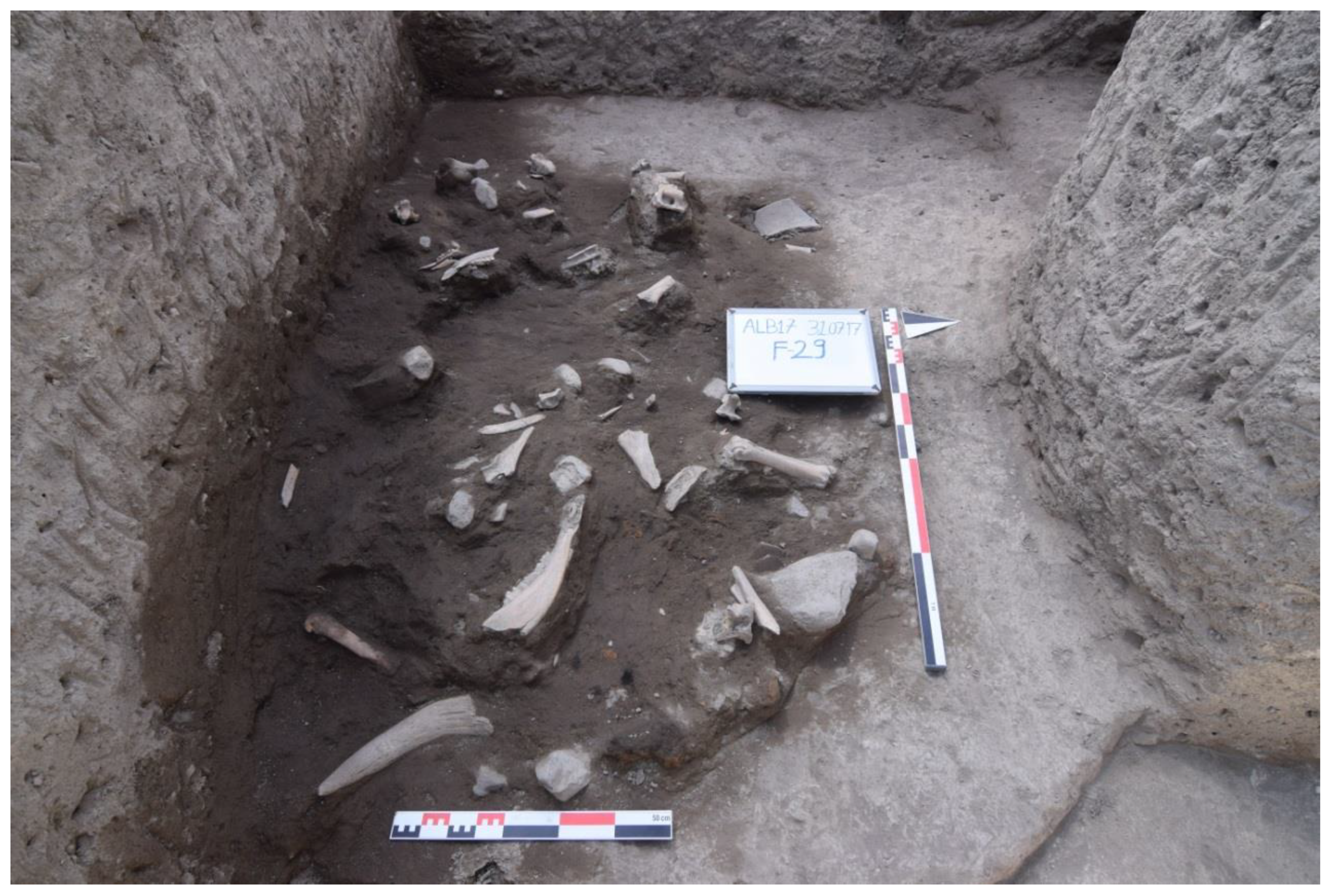
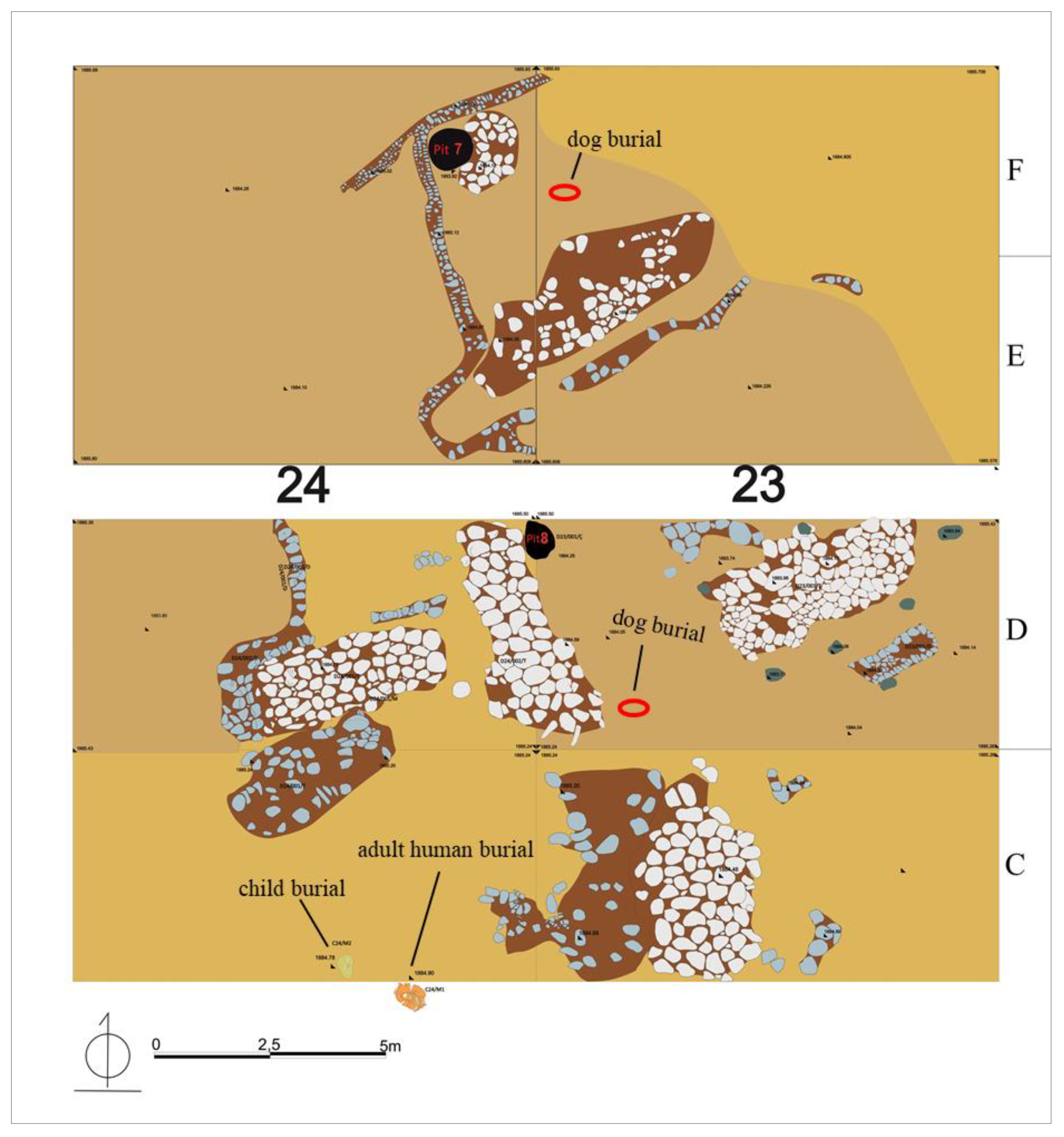
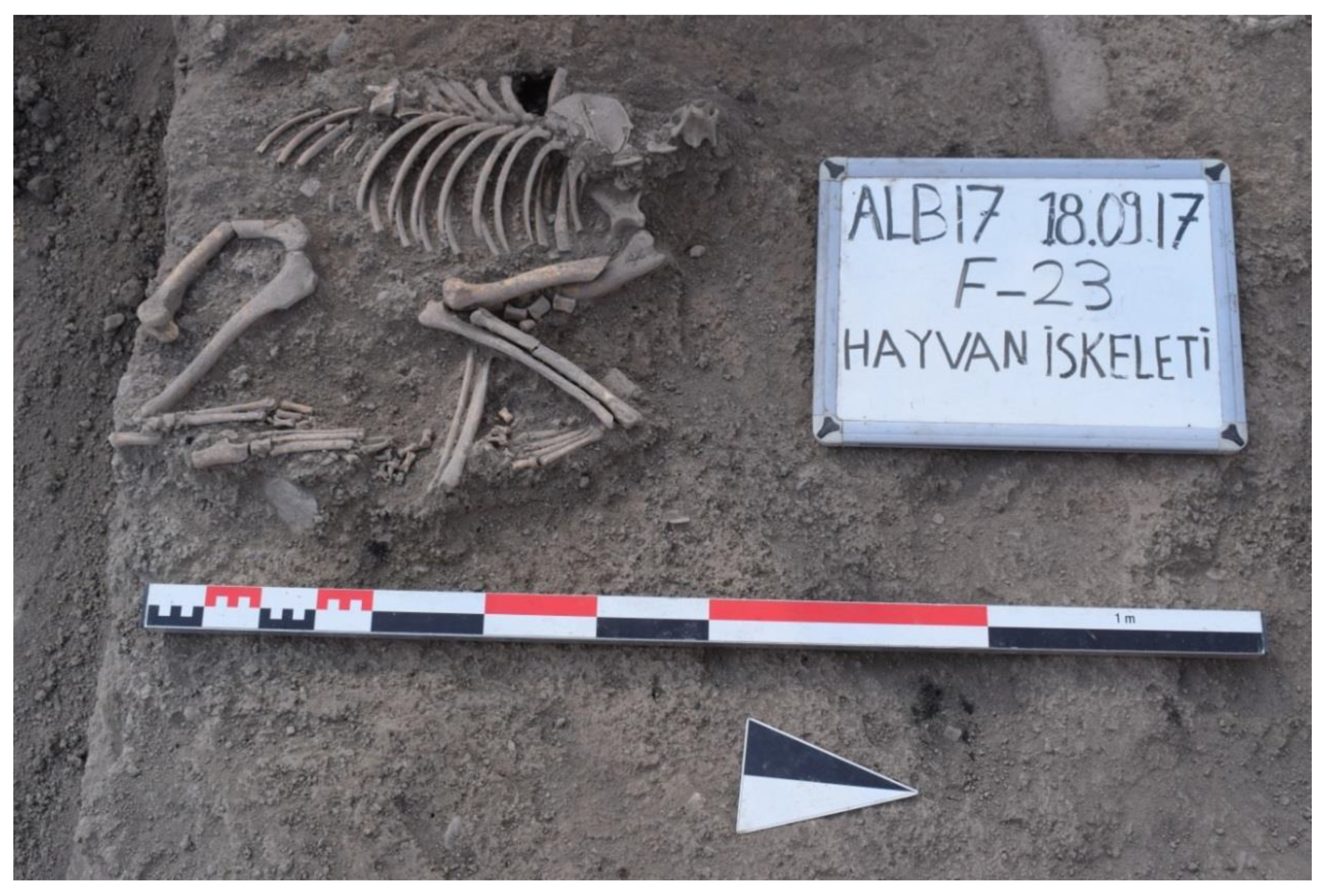
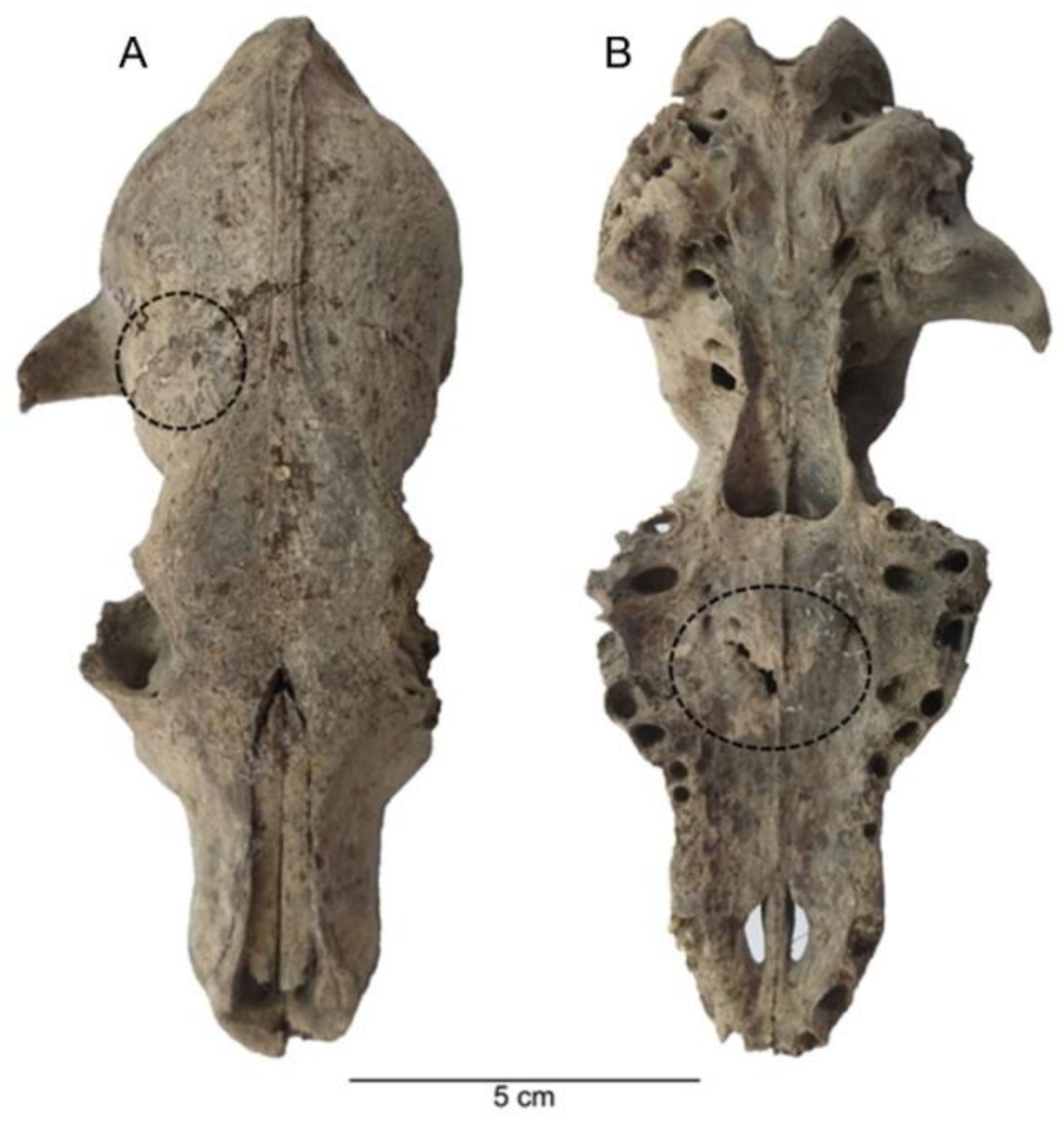
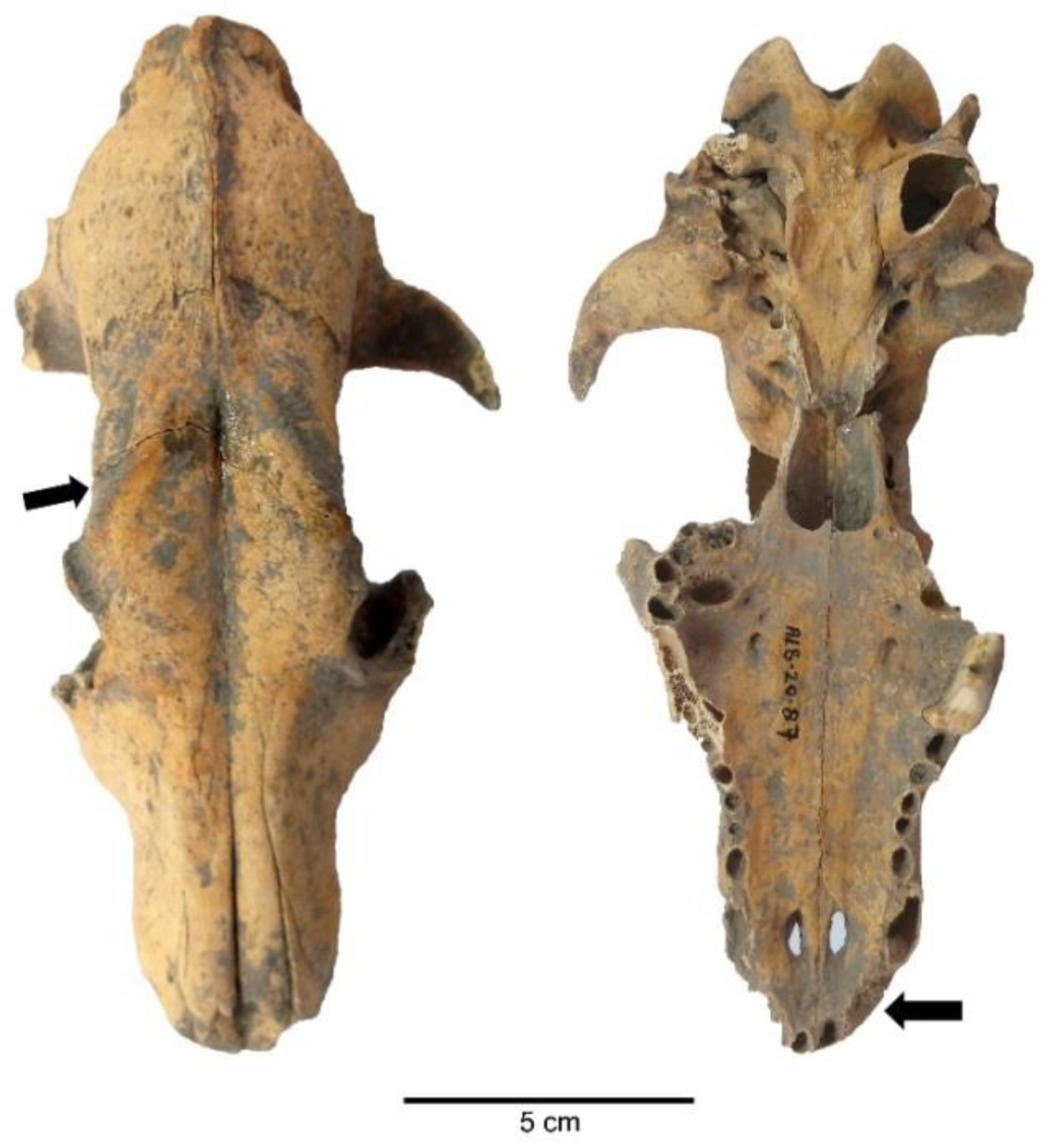
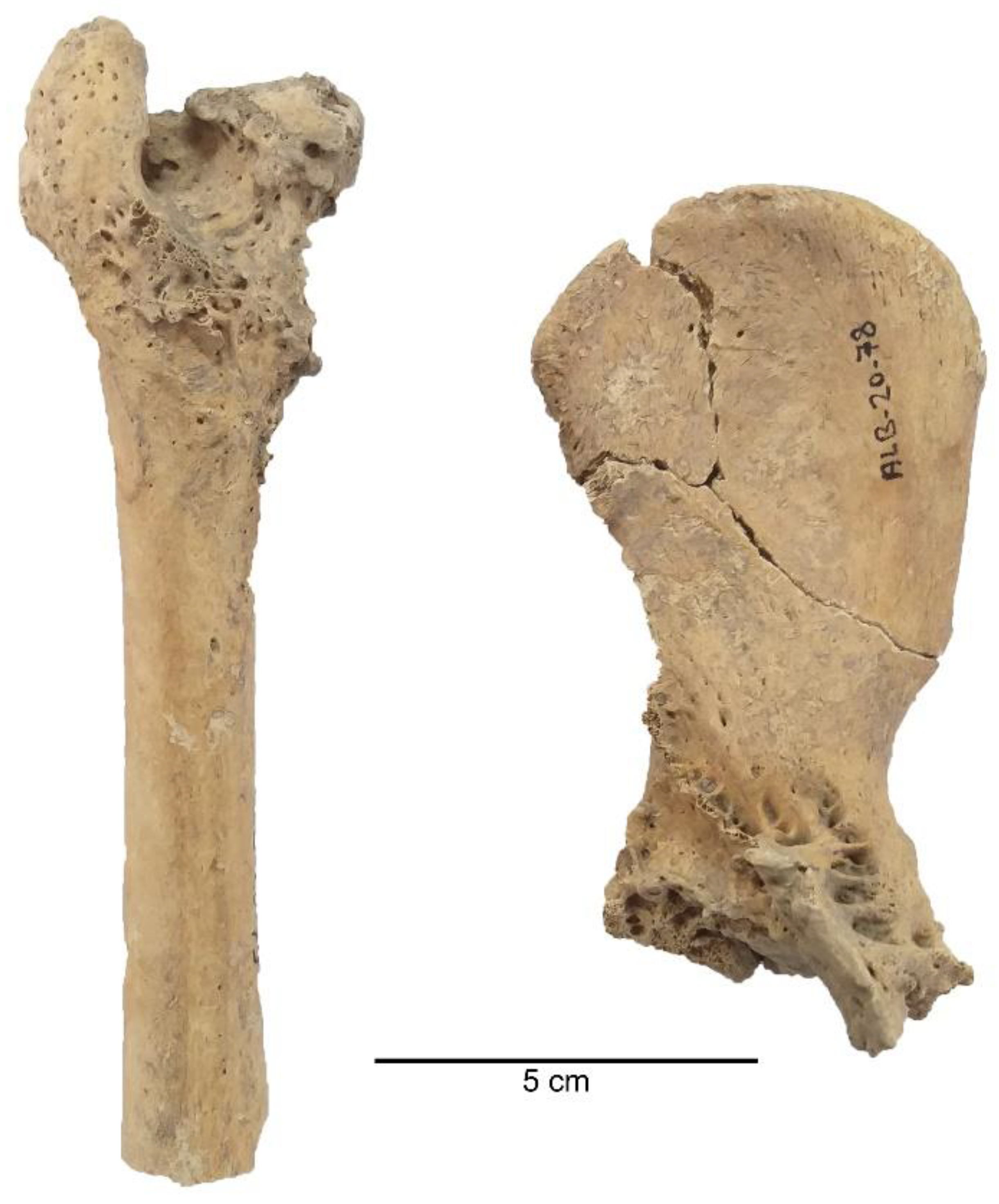
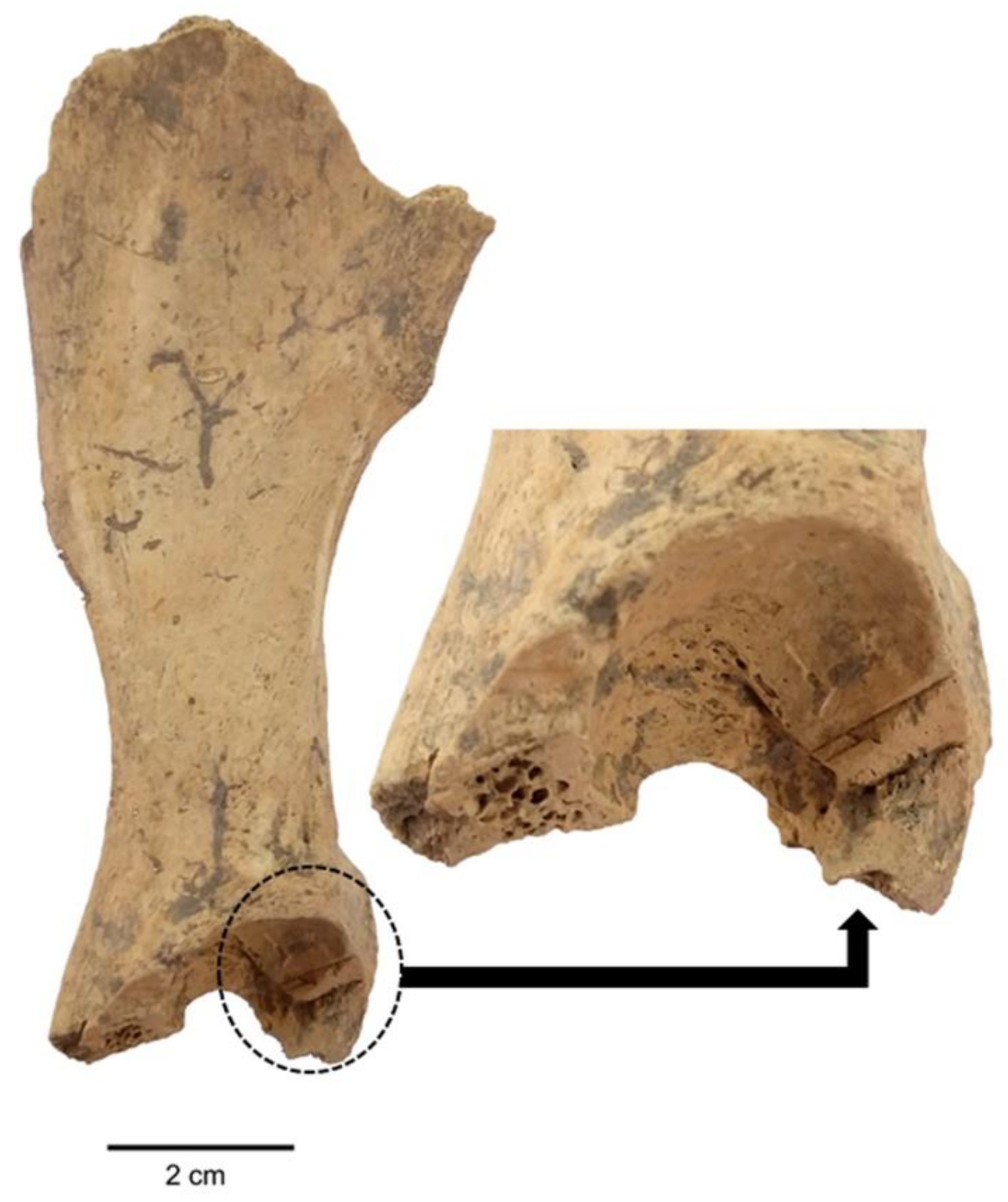

| Dog Breeds | Number | Dog Breeds | Number |
|---|---|---|---|
| French bulldog | 1 | St. Bernard | 2 |
| Pekingese | 1 | Rotweiller | 2 |
| Boxer | 3 | Kangal dog | 3 |
| Terrier | 3 | Irish setter | 1 |
| Cocker spaniel | 1 | German shepherd | 5 |
| Clumber spaniel | 1 | Pointer | 1 |
| Canaan dog | 1 | Siberian husky | 1 |
| Great Dane | 1 | Doberman | 3 |
| Mastiff | 1 | Mixbreed | 6 |
| Early-Middle Iron Age | Late Iron Age | ||||||||||||||||||
|---|---|---|---|---|---|---|---|---|---|---|---|---|---|---|---|---|---|---|---|
| Archaeological Context | Workshop Complex | Pit 2 | Pit 1 | Well 1 | Structure B | Pit 4 | Structure A | Courtyard | Structure A | Courtyard | Architectural Remains | ||||||||
| Trench | D 23 | E 23 | F 23 | E 24 | F 24 | E 27 | F 27 | E 32 | F 28 | E-F 29 | F 29 | E 30 | E 31 | E 28 | E 29 | F 30 | F 31 | F 32 | NISP |
| Skull | 1 | 1 | 1 | 1 | 1 | 1 | 1 | 7 | |||||||||||
| Mandible | 2 | 1 | 2 | 2 | 1 | 1 | 1 | 10 | |||||||||||
| Atlas | 1 | 1 | 1 | 1 | 4 | ||||||||||||||
| Axis | 1 | 1 | 2 | 1 | 2 | 7 | |||||||||||||
| Sacrum | 2 | 1 | 3 | ||||||||||||||||
| Scapula | 2 | 2 | 1 | 5 | |||||||||||||||
| Humerus | 2 | 4 | 2 | 1 | 1 | 1 | 1 | 1 | 13 | ||||||||||
| Radius | 2 | 2 | 2 | 1 | 1 | 1 | 9 | ||||||||||||
| Ulna | 2 | 2 | 1 | 5 | |||||||||||||||
| Metacarpus | 7 | 1 | 9 | 1 | 1 | 1 | 20 | ||||||||||||
| Pelvis | 1 | 2 | 1 | 1 | 2 | 7 | |||||||||||||
| Baculum | 1 | 1 | |||||||||||||||||
| Femur | 2 | 1 | 2 | 5 | |||||||||||||||
| Patella | 3 | 2 | 5 | ||||||||||||||||
| Tibia | 3 | 2 | 4 | 1 | 1 | 1 | 2 | 2 | 16 | ||||||||||
| Fibula | 2 | 2 | 4 | ||||||||||||||||
| Calcaneus | 1 | 2 | 3 | ||||||||||||||||
| Talus | 1 | 2 | 3 | ||||||||||||||||
| Metatarsus | 5 | 8 | 1 | 1 | 1 | 16 | |||||||||||||
| Total | 38 | 15 | 47 | 5 | 4 | 3 | 5 | 2 | 4 | 1 | 3 | 5 | 1 | 1 | 4 | 1 | 2 | 2 | 143 |
| Individual No. | Number of Bones |
|---|---|
| ALB No. 1 | 45 |
| ALB No. 2 | 1 |
| ALB No. 3 | 1 |
| ALB No. 4 | 1 |
| ALB No. 5 | 1 |
| ALB No. 6 | 1 |
| ALB No. 7 | 37 |
| ALB No. 8 | 1 |
| ALB No. 9 | 1 |
| ALB miscellaneous | 54 |
| NISP | 143 |
| Individual No. | Sex | Height at Withers | Body Weight |
|---|---|---|---|
| ALB No. 1 | Female | 60.90 | 39.19 |
| H, R, Fe, Ti | H, Fe | ||
| ALB No. 2 | Male | 57.46 | 27.77 |
| H, R, Fe, Ti | H, Fe | ||
| ALB No. 3 | Undetermined | 43.64 | |
| Fe | |||
| ALB No. 4 | Undetermined | 59.46 | 29.67 |
| H | H | ||
| ALB No. 5 | Undetermined | 60.43 | |
| R | |||
| ALB No. 6 * | Undetermined | 21.54 | |
| H | |||
| ALB No. 7 | Male | 64.23 | 45.44 |
| H, R, U, Fe, Ti | H, Fe |
| Skull | Humerus | Radius | Ulna | Femur | Tibia | |||||||||||||
|---|---|---|---|---|---|---|---|---|---|---|---|---|---|---|---|---|---|---|
| N | TL | Z Score | N | GL | Z Score | N | GL | Z Score | N | GL | Z Score | N | GL | Z Score | N | GL | Z Score | |
| ALB No. 1 | 2 | 184.76 * | 0.481 | 2 | 183.65 * | 0.246 | 2 | 201.24 * | 0.675 | 2 | 204.42 * | 0.521 | ||||||
| ALB No. 2 | 1 | 175.25 | −0.600 | |||||||||||||||
| ALB No. 4 | 1 | 181.09 | 0.064 | |||||||||||||||
| ALB No. 5 | 1 | 183.91 | 0.269 | |||||||||||||||
| ALB No. 7 | 1 | 195.04 | 1.648 | 2 | 192.65 * | 1.032 | 2 | 226.71 * | 1.468 | 1 | 214.12 | 1.778 | 2 | 219.32 * | 1.680 | |||
| ALB No. 8 | 1 | 165.87 | −2.637 | |||||||||||||||
| ALB No. 9 | 1 | 198.61 | 0.089 | |||||||||||||||
| YT M6 ** | 18 | 199.24 | 35 | 180.52 | 49 | 180.72 | 37 | 205.81 | 37 | 192.9 | 45 | 197.48 | ||||||
| YT M5 *** | 1 | 206.55 | 1 | 166.86 | 1 | 168.43 | 1 | 185.35 | 1 | 181.61 | 1 | 180.23 | ||||||
| Skull | Humerus | Radius | Ulna | Femur | Tibia | |||||||||||||
|---|---|---|---|---|---|---|---|---|---|---|---|---|---|---|---|---|---|---|
| N | TL | Z Score | N | GL | Z Score | N | GL | Z Score | N | GL | Z Score | N | GL | Z Score | N | GL | Z Score | |
| ALB No. 1 | 2 | 184.76 * | 0.217 | 2 | 183.65 * | 0.113 | 2 | 201.24 * | 0.204 | 2 | 204.42 * | 0.182 | ||||||
| ALB No. 2 | 1 | 175.25 | −0.051 | |||||||||||||||
| ALB No. 4 | 1 | 181.09 | 0.114 | |||||||||||||||
| ALB No. 5 | 1 | 183.91 | 0.119 | |||||||||||||||
| ALB No. 7 | 1 | 195.04 | 0.507 | 2 | 192.65 * | 0.334 | 2 | 226.71 * | 0.364 | 1 | 214.12 | 0.517 | 2 | 219.32 * | 0.525 | |||
| ALB No. 8 | 1 | 165.87 | −1.113 | |||||||||||||||
| ALB No. 9 | 1 | 198.61 | −0.141 | |||||||||||||||
| Modern dog ** | 37 | 204.49 | 176.29 | 178.45 | 208.92 | 192.04 | 195.67 | |||||||||||
Publisher’s Note: MDPI stays neutral with regard to jurisdictional claims in published maps and institutional affiliations. |
© 2021 by the authors. Licensee MDPI, Basel, Switzerland. This article is an open access article distributed under the terms and conditions of the Creative Commons Attribution (CC BY) license (https://creativecommons.org/licenses/by/4.0/).
Share and Cite
Siddiq, A.B.; Onar, V.; Mutuş, R.; Poradowski, D. The Iron Age Dogs from Alaybeyi Höyük, Eastern Anatolia. Animals 2021, 11, 1163. https://doi.org/10.3390/ani11041163
Siddiq AB, Onar V, Mutuş R, Poradowski D. The Iron Age Dogs from Alaybeyi Höyük, Eastern Anatolia. Animals. 2021; 11(4):1163. https://doi.org/10.3390/ani11041163
Chicago/Turabian StyleSiddiq, Abu B., Vedat Onar, Rıfat Mutuş, and Dominik Poradowski. 2021. "The Iron Age Dogs from Alaybeyi Höyük, Eastern Anatolia" Animals 11, no. 4: 1163. https://doi.org/10.3390/ani11041163
APA StyleSiddiq, A. B., Onar, V., Mutuş, R., & Poradowski, D. (2021). The Iron Age Dogs from Alaybeyi Höyük, Eastern Anatolia. Animals, 11(4), 1163. https://doi.org/10.3390/ani11041163








